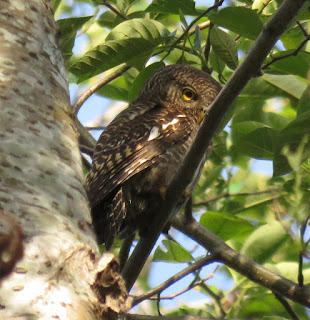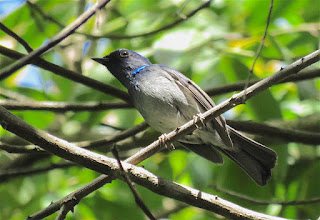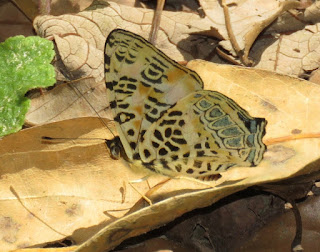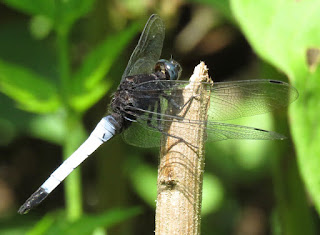In the
remaining time of my vacation in Kathmandu I mostly stayed in and worked on my
computer – finalizing the menu and shopping lists for the WINGS Gambell
tour (where I’m the chef rather than a leader), catching up on blog writing,
and working on the talk I was to give in New York. But I did get out birding
for a full morning with my friend and top Nepal birder Som GC. On April 26 (now
over three weeks ago!) Som picked me up on his motorbike and we went to
Phulchowki, a forested hill just south of Kathmandu. Kate and Mich live on the
north side of the city, so it’s about an hour’s drive through the winding
streets and unruly traffic of dirty, dusty, and polluted Kathmandu until we
emerged on the other side and more trees and open land appeared. We parked by a
row of little shacks selling food near the base of the hill, and right across
the street we saw this Asian Barred Owlet.
From there
we walked about a kilometer up the road until we were in really nice forest,
and the spring exuberance was in full swing here. Som was calling out the songs
of one species after another, all birds that I’d had seen at least once before
but really enjoyed getting to know again. Gray-headed Canary-Flycatcher,
Striated Laughingthrush, Maroon Oriole, Gray Treepie, and Pygmy Cupwing were
some of the sounds we heard in a confusing chorus, and I saw some of them as
well. But Som then heard a couple birds that made him think a bit more – the
first being my lifer Large Niltava, a scarce bird in Nepal. I got a recording
of the distinctive song of four or more whistles incrementally rising in pitch,
but no photo. I did get a photo of the much more common Little Niltava, in the
same genus; both are members of Muscicapidae, the Old World Flycatchers.
The other
song that Som had to think about belonged to the almost equally scarce Pale
Blue-Flycatcher, which I recorded and photographed. I had glimpsed and recorded
this species in Borneo almost exactly four years ago, but I wasn’t able to
identify it at the time, much later matching the song. So this was very much
like a lifebird. I later learned that these two species are rare enough in
Nepal that even Mich hadn’t seen them here before. (Mich has since gone to
Phulchowki, catching up on the Pale Blue-Flycatcher but finding a much rarer
bird, Hodgson’s Hawk-Cuckoo, as well as Bay Woodpecker, both of which would be
new for me.)
I got just
two other useful photos of birds. This is a Little Pied Flycatcher, which I
also first saw in Borneo four years ago.
And this is White-tailed
Nuthatch, which was new for me in this same spot last year.
The most
astonishing thing we saw this morning was an irruption of earthworms, unlike
anything either of us have seen. Or maybe one could call it a population
explosion, a mass migration, or a region-wide takeover. Som has been to
Phulchowki dozens of times over the years, every month in every kind of
weather, and he had no idea what was going on here. Only one bird, a
Gray-winged Blackbird, seemed to be taking advantage of the abundance. But if
this is something extraordinary, there wouldn’t be a population of birds that
expects it and knows to take advantage of it. It has been unusually rainy for
April, but the soil wasn’t at all saturated, and even if it were, it would be
hard to fathom this number of worms living under the surface under more normal
conditions. It would take a special effort to estimate the numbers up and down
a few hundred meters of the road, and many were buried under a huge pile of
castings along the side of the road. They weren’t mating, and the general
direction was downslope. It was really unbelievable. I tried several Google
searches to see if there was any information online about this phenomenon and
found nothing. In fact, the only occurrence of the phrase “earthworm irruption”
on the entire World Wide Web appears to be the title of my own video below,
which I uploaded to Youtube.
The early
rains have resulted in a much greater diversity of butterflies than last year,
which was unusually dry. Several members of the white family Pieridae are
called Jezabels. This is Delias
belladonna, Hill Jezabel.
I
photographed two hairstreaks:
Cigaritis nipalicus, Silver-gray
Silverline
Ancema ctesia, Bispot Royal
Metalmarks don’t
seem to be as diverse here as in the New World, so I was surprised to find that
three of these were indeed in Riodinidae. I don’t know who coined all these
English names, but I suspect they are quite old, and it’s probably a complete
coincidence that I saw two punches and a judy on the same morning:
Dodona adonira, Striped Punch
Dodona eugenes, Tailed Punch
Abisara fylla, Dark Judy
I photographed
five species in the giant family Nymphalidae, the brushfoots.
This Kallima inachus, Orange Oakleaf looks like
it would be related to our leafwings (subfamily Charaxinae) but it’s actually
in a different subfamily, Nymphalinae.
This Kaniska canace, Blue Admiral is actually
in the same subfamily and tribe as our Painted Lady.
Symbrenthia hypselis, Himalayan Spotted
Jester is also in the same tribe.
The many
species of sailors in the genus Neptis
sp. are very similar, so I’m not sure this one can be narrowed down any
further. It’s related to our admirals and sisters.
This satyr
is Lethe baladeva, Treble Silverstripe.
This diurnal
moth was surprisingly easy to find a name for; it is Campylotes histrionicus in the family Zygaenidae.
As far as I
can tell, this is the same Coccinella
septempunctata, Seven-spotted Lady Beetle that is now a widespread and
common introduced species in North America, originating from Eurasia.
Nearly back
to Som’s motorbike, we passed by a wet ditch with these two related dragonflies:
Orthetrum pruinosum, Crimson-tailed
Marsh Hawk
Orthetrum triangulare, Blue-tailed Forest Hawk





























No comments:
Post a Comment